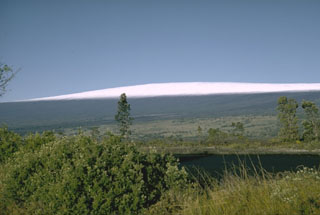Report on Mauna Loa (United States) — 23 November-29 November 2022
Smithsonian Institution / US Geological Survey
Weekly Volcanic Activity Report, 23 November-29 November 2022
Managing Editor: Sally Sennert.
Please cite this report as:
Global Volcanism Program, 2022. Report on Mauna Loa (United States) (Sennert, S, ed.). Weekly Volcanic Activity Report, 23 November-29 November 2022. Smithsonian Institution and US Geological Survey.
Mauna Loa
United States
19.475°N, 155.608°W; summit elev. 4170 m
All times are local (unless otherwise noted)
An eruption at Mauna Loa began at about 2330 on 27 November in Moku‘aweoweo, the summit caldera, prompting HVO to raise the Aviation Color Code to Red (the highest level on a four-color scale) and the Volcano Alert Level to Warning (the highest level on a four-level scale). A thermal anomaly and a plume of sulfur dioxide gas were identified in satellite images at the onset of the eruption, according to NOAA’s National Environmental Satellite, Data, and Information Service (NESDIS). Hawai‘i Volcanoes National Park closed the summit area to visitors. Lava erupted from a fissure in the caldera and by 0127 on 28 November lava had overflowed the caldera walls. During an overflight at about 0630 scientists confirmed that the eruption had moved from the summit to the Northeast Rift Zone, where three fissures opened at a high elevation. The fissures fed several lava flows that traveled N and NE; the flows were active in the “saddle” area between Mauna Loa and Mauna Kea and were not threatening any populated areas. Lava fountains along the fissures were as tall as 30-60 m, though most were only a few meters tall. Lava flows from fissures 1 and 2 traveled downslope and stalled about 18 km from the Saddle Road; the two fissures were inactive by 1330. Sulfur dioxide emissions were approximately 250,000 tonnes per day.
Fissure 3, at the lowest elevation of the NE fissures, issued the longest lava flows. Lava flows crossed the Mauna Loa Weather Observatory Road at about 2000 on 28 November; by 0700 on 29 November the flow front was about 10 km from the Saddle Road. Lava fountains at Fissure 3 were 25 m high in the morning on 29 November but had grown to 40-50 m tall in the afternoon. Fissure 4, downslope of Fissure 3, opened at about 1930 and produced lava fountains that rose 5-10 m high. There was no activity in the summit caldera, nor along the Southwest Rift Zone. Gas plumes from the activity drifted N.
Geological Summary. Massive Mauna Loa is a basaltic shield volcano that rises almost 9 km from the ocean floor to form the world's largest Holocene volcano. Flank eruptions typically occur from the lengthy NE and SW rift zones, and from the Moku'aweoweo summit is caldera, which is within an older and larger 6 x 8 km caldera. Two of the youngest large debris avalanches documented in Hawaii traveled nearly 100 km from Mauna Loa; the second of the Alika avalanches was emplaced about 105,000 years ago (Moore et al., 1989). Almost 90% of the surface of the volcano is covered by lavas less than 4,000 years old (Lockwood and Lipman, 1987). Beginning about 1,500 years ago, a series of voluminous overflows from a summit lava lake covered about 25% of the volcano's surface. Over the last 750 years, from shortly after the formation of Moku'aweoweo caldera until the present, an additional 25% of the volcano has been covered with lava flows, mainly from summit and NW rift zone vents.
Sources: US Geological Survey Hawaiian Volcano Observatory (HVO), National Environmental Satellite, Data, and Information Service (NESDIS)

